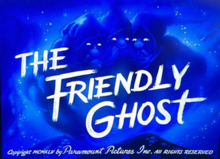The Friendly Ghost
| The Friendly Ghost | |
|---|---|
 Restored title card | |
| Directed by | I. Sparber[1][2] Animation director: Nick Tafuri (uncredited) |
| Story by | Adaptation: Bill Turner Otto Messmer[3] |
| Based on | Casper the Friendly Ghost by Joe Oriolo and Seymour Reit[3][4] |
| Produced by | Sam Buchwald[1] I. Sparber (uncredited) Seymour Kneitel (uncredited) Bill Tytla (uncredited) |
| Starring | Cecil Roy[1][3] Mae Questel Jackson Beck[3] Jack Mercer |
| Narrated by | Frank Gallop[1][3] |
| Music by | Winston Sharples |
| Animation by | Nick Tafuri Tom Golden John Walworth[1][2] Character design: John Walworth[1] Joe Oriolo (uncredited) |
| Layouts by | Shane Miller Lloyd Hallock Jr.[1] John Walworth (uncredited) |
| Backgrounds by | Shane Miller Lloyd Hallock Jr.[1] |
| Color process | Technicolor |
Production company | |
| Distributed by | Paramount Pictures |
Release date | November 16, 1945 |
Running time | 8:57[2] |
| Country | United States |
| Language | English |
The Friendly Ghost is a Famous Studios cartoon released on 16 November 1945 as part of its Noveltoons series of animated short films. It is the first cartoon to feature the character Casper the Friendly Ghost.[5]
Plot
Casper is seen reading the book How to Win Friends, a real book by Dale Carnegie. Every night at midnight his brothers and sisters scare people, except for Casper, who doesn't want to scare people, so he stays home instead; he would rather make friends with the living. While his family is off scaring people, Casper bids his pet cat goodbye and leaves home.
The next morning, he meets a rooster to whom he says hello but the rooster retreats. Casper next meets a mole. At first the mole is happy to befriend him but when he puts on eyeglasses, he sees that Casper is a ghost and jumps back in his hole. Casper later meets a mouse and a cat (who each resemble Herman and Katnip) and who flee into the barn upon seeing him. Casper then sees a flock of chickens who fly away with their hen house and splatter eggs on him.
Near some rail tracks, Casper grows sad that his attempts to make friends have been fruitless because he's "just a scary old ghost". When he hears a train whistle he decides to kill himself by having the train run over him, apparently forgetting that he is already dead. After the train passes over Casper without harming him, he begins crying. Casper is approached by a boy and a girl named Johnny and Bonnie who want to play with him, which makes Casper very happy.
After a game of ball and jump rope, Bonnie and Johnny introduce Casper to their mother, who screams and tells Casper to leave. Casper picks up his sack and is about to go through the door when a banker opens it. The banker orders Casper to tell the mother he has come for a mortgage payment, but then he realizes that Casper is a ghost. Terrified, he tears up the mortgage which he tells Casper to keep (because he doesn't want to have a "haunted" house on the market) and runs off in fright, so fast that he sets a bridge on fire.
Despondent, Casper decides to go back home to his own family, accepting that he will never be anything but "a scary old ghost without any friends". He is about to leave in despair when the mother picks him up with a smile on her face, accepting him for saving her and the children from having their home repossessed. The short concludes with the mother seeing Casper now wearing schoolboy clothes, Bonnie, and Johnny off to school together.
Voice cast
- Cecil Roy as Casper,[1] Bonnie[3]
- Mae Questel as Johnny, Mother
- Jackson Beck as Landlord[3]
- Jack Mercer as Ghost, Rooster
Legacy
Despite being designed as a one-shot character, Casper's appearance in this short lead to a flurry of future appearances as a staple for Famous Studios and Paramount, including his own animated short film series. Casper has been regarded as an "iconic supernatural ghost character in children's literature and television".[6] The release of this short in 1945, according to Nathalie Op de Beeck, coincided with the end of World War II and subsequently reflected the times with its imagery as she asserts that "[t]he film links supernatural horror to an acknowledgement of actual weaponry".[7]
Copyright status
The short had an initial copyright notice, but it was not renewed.[8][9]
See also
References
- ^ a b c d e f g h i Webb, Graham (2011). The Animated Film Encyclopedia: A Complete Guide to American Shorts, Features and Sequences (1900-1999). McFarland & Company, Inc. p. 130. ISBN 978-0-7864-4985-9.
- ^ a b c "The Friendly Ghost (1945): Main". The Big Cartoon DataBase. Retrieved 19 September 2022.[dead link]
- ^ a b c d e f g "The Friendly Ghost (1945): Cast". The Big Cartoon DataBase. Retrieved 19 September 2022.[dead link]
- ^ Stanchfield, Steve (29 October 2020). "Halloween is Better with Casper…". Cartoon Research.
- ^ Lenburg, Jeff (1999). The Encyclopedia of Animated Cartoons. Checkmark Books. pp. 63–64. ISBN 0-8160-3831-7. Retrieved 6 June 2020.
- ^ Ferrier-Watson, Sean (2017). The Children's Ghost Story in America. McFarland, Incorporated, Publishers. ISBN 9781476664941.
- ^ Johnson, Crockett; Farrow, Theodore; Morley, Jack (2016). Barnaby. Fantagraphics Books. p. 15. ISBN 9781606998236. Retrieved May 8, 2023.
- ^ Office, Library of Congress Copyright (1946). Catalog of Copyright Entries. Part 1. [C] Group 3. Dramatic Composition and Motion Pictures. New Series.
- ^ https://archive.org/details/catalogofc19733271213libr/page/44/
External links
- The Friendly Ghost at IMDb
- The short film The Friendly Ghost is available for free viewing and download at the Internet Archive.
